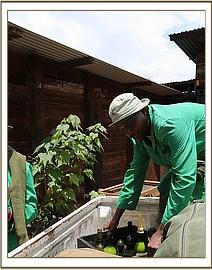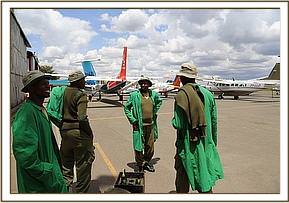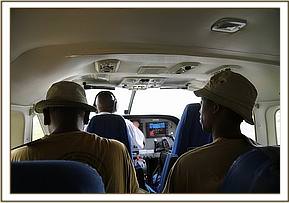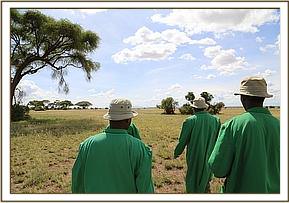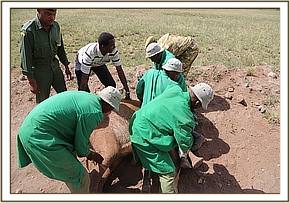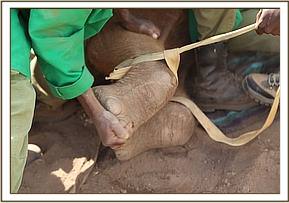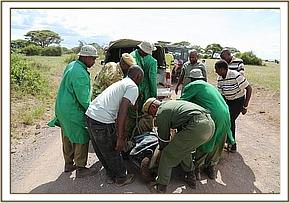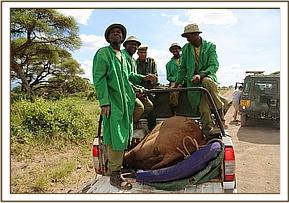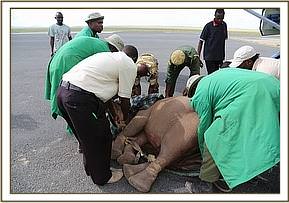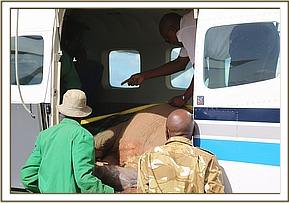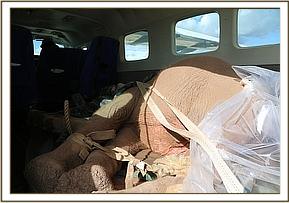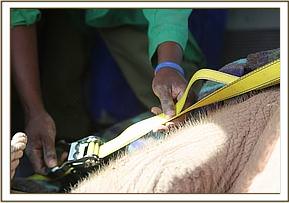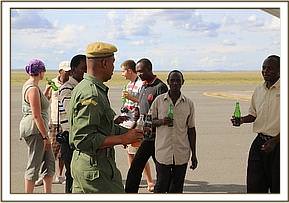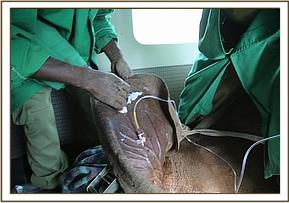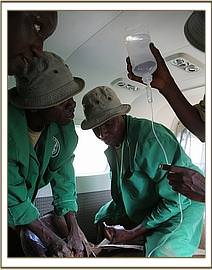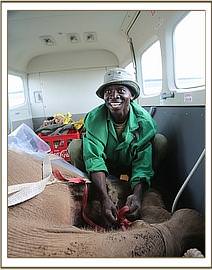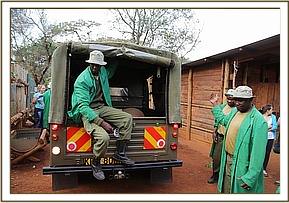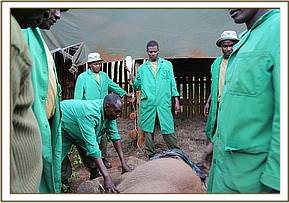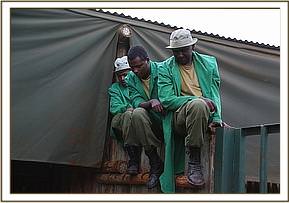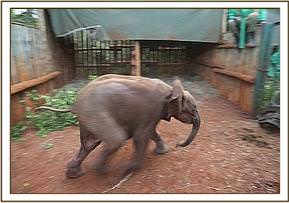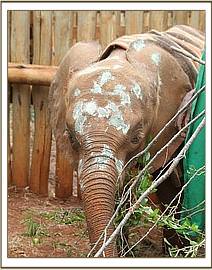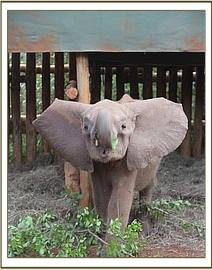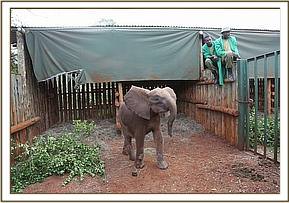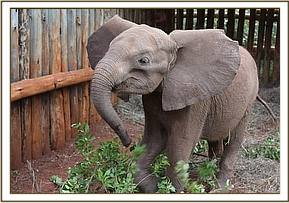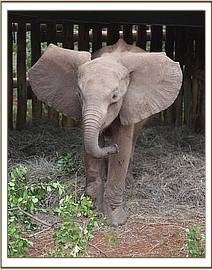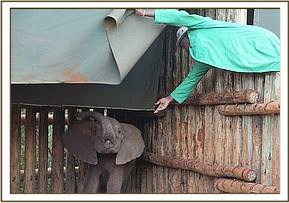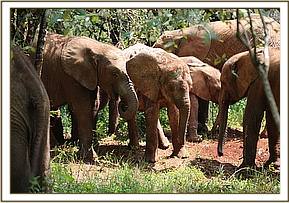






Now living wild, though he remains an integral part of our Umani herd
Current age
14 years old
Gender
Male
Rescued date
27 March 2013
Rescue location
Amboseli Ecosystem, Amboseli National Park
Date of birth (estimate)
15 December 2011
Reason orphaned
Poaching
Age at rescue
15 months old (approx)
Current location
Umani Springs Reintegration Unit
On closer inspection the team suddenly realised who the calf was, immediately noticing the unique albino colouring, the approximate age and that he was a young male. The calf was ‘Jasiri’ a beautiful little boy born in December 2011 to ‘Jemima’, the matriarch of the JB family, who have been studied by ATE for years. Jasiri was the first albino calf documented in Amboseli in the 40 years the ATE have been following the elephants there.
A year after Jasiri’s birth tragedy struck during Christmas 2012, when the ATE found Jemima's carcass, suspected to have been shot by poachers, although her tusks were found intact. Jemima’s daughter Jalila and her grand-daughter, Jasiri's age mate, were also missing from the scene whilst there was no trace of her son Jasiri. After months passed, everyone gave up hope of ever finding any of them again.
Then the fateful day came nearly three months later when Jasiri - whose name means "brave" in Kiswahili, appeared alone in the Park having wandered almost 20km from the site where his mother was brutally murdered. It is believed Jasiri survived because he was in such good condition before his mother died, and because the environment of Amboseli had been plentiful during that period. Another explanation could be that Jasiri was embraced by another lactating female from another herd during his three month disappearance, and he was able to suckle enough precious milk to keep him alive, as with experience it is known that the likelihood of an elephant of his age surviving without milk for longer than around six weeks is near impossible, although as we also all know, miracles do happen.
When the report was received from Amboseli, the Nairobi Rescue Team was immediately deployed with the milk formula and all the necessary medicines and supplies for the mission. Heading to Nairobi’s domestic airport the team arrived swiftly at 1.30pm and were greeted by the familiar airline handlers who organised all of the flight plans and got the team quickly on board the waiting plane.
Flying southwest towards Amboseli National Park storms darkened the skies to the east and thick clouds blinded the land below, yet after just thirty minutes the plane soon began to drop in elevation, skimming smoothly over the flat green plains of Amboseli where elephants meandered through the shallow lakes dotting the landscape below.
Awaiting the rescue plane at the airstrip was one of the ATE’s staff, who quickly transferred the team of eager Keepers to the site of the orphan. A short ten kilometres from the airstrip, having passed a host of wildlife, the ATE field team was soon spotted on the side of the road, keeping an eye on the young elephant they had found that morning. After greetings were made and the ATE staff briefed the Keepers, the quick decision was made for the four SWT Keepers to approach the calf Jasiri on foot, who was standing quietly in the shade only thirty metres away from the vehicles at the edge of a bush. With ropes and blankets in hand the Keepers slowly approached the baby elephant, who eyed them suspiciously, yet made no effort to move. Moving ever closer the team reached about ten feet away from the calf before he suddenly got frightened, charged aggressively at them a couple of times, the Keepers holding ground, before he ran off away from both the vehicles and the ground teams. Despite clearly having energy and strength the calf wasn’t able to outrun the Nairobi Keepers who were hot on his tail. Chasing the baby for about fifty metres the Keepers, perfectly in unison, ambushed the calf, each Keeper seizing him as smoothly as possible from every side, holding him firm until the rest of the backup teams reached the calf, with joint strength everyone managed to bring the calf to the ground in order to bind his legs and keep him from escaping or hurting himself.
With perfect timing, team work and fearlessness from the Nairobi Keepers, the entire physical rescue took less than five minutes, saving the calf a lot of stress and pain. Cooling him with water, the Keepers then prepared the orphan for getting into the ATE vehicle to be transferred to the waiting plane on the airstrip. At such a hefty size, it was no easy feat for the teams to lift Jasiri into the vehicle, yet with combined strength he was soon safely on board and on his way to the airstrip.
Before being transferred into the plane, Jasiri was given all the necessary medications he needed for the journey as well as an injection of Stresnil to keep him calm and as relaxed as possible. Again with teamwork Jasiri’s bulk was shifted slowly into the plane and the Keepers secured him in place with straps before putting him on a drip, as it was obvious that, even though he was in relatively good health considering his ordeal, he was clearly extremely dehydrated.
Departing Amboseli at 4pm, the flight went smoothly, two of the Keepers sitting with Jasiri in the back of the plane, keeping the drip in place and keeping the scared orphan company, giving him care and reassurance. After forty-five minutes the aircraft soon dropped low over Nairobi before landing at Wilson airport, where the SWT driver and vehicle were waiting. Jasiri had remained calm and quiet throughout the journey and was now on his way to Nairobi National Park and the SWT Nursery.
Arriving at the Nursery at 5.30pm, the vehicle manoeuvredJasiri closer to his new stockade, where all of the Nairobi Keepers were at hand to carry him gently into the safety of the stockade before slowly removing the straps which were holding him securely. The Keepers knew Jasiri would put up a fight when he was released even though he must have been completely exhausted after the rescue, so they all took to the rafters of the stockade having quickly untied him. As expected Jasiri bounced up and immediately charged the Keepers, running around the stockade keeping everyone away from him, before he couldn’t deny the temptation of the fresh greens placed in front of him, taking a good few mouthfuls before charging at the Keepers once more.
Just like Faraja, Jasiri is another unique and special baby, displaying the wonderful albino colourings seemingly limited to the beautiful Amboseli area; it is even believed that Jasiri could indeed be, in some way related to Faraja with their tight family connections and their exceptional genetic chemistry.
Jasiri’s story is one of sadness and pain, yet a miracle has unfolded and he has reappeared, surviving to live another day with many secret stories from his three months alone. He will hopefully thrive at the Nairobi Nursery with the care of the Keepers and the love and company of the other orphans, one day getting the chance to return to the wilds of Tsavo to enjoy his life as he was destined to.
On closer inspection the team suddenly realised who the calf was, immediately noticing the unique albino colouring, the approximate age and that he was a young male. The calf was ‘Jasiri’ a beautiful little boy born in December 2011 to ‘Jemima’, the matriarch of the JB family, who have been studied by ATE for years. Jasiri was the first albino calf documented in Amboseli in the 40 years the ATE have been following the elephants there.

View diary updates from across all our orphan units as written by the Keepers

Our extended elephant family continues to grow! Zongoloni has given birth to a beautiful baby boy — her first calf and our fourth Umani grandchild.
By adopting, you play a vital role in the life of an orphaned elephant, rhino, or giraffe — helping us provide the round-the-clock, loving attention each one needs and deserves over many years, so they can ultimately reclaim their place in the wild.
Your adoption supports the 100+ orphans in our care at any given time, covering the cost of milk and food supplies, Keepers' salaries, veterinary treatment, and other essentials.

Celebrate your adoption with a personalised certificate, ready for you or your lucky gift recipient to print and display!

Each month, we send a detailed update about our Orphans’ Project direct to your email inbox, featuring photos, stories, and special highlights.

From the latest Keepers’ Diaries to a downloadable image gallery and more, adopters have exclusive access to our content library.
